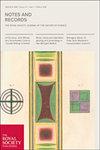早期现代眼睛模型的制作
IF 0.6
3区 哲学
Q3 HISTORY & PHILOSOPHY OF SCIENCE
Notes and Records-The Royal Society Journal of the History of Science
Pub Date : 2023-11-15
DOI:10.1098/rsnr.2023.0020
引用次数: 0
摘要
17世纪,解剖眼模型在欧洲越来越流行。它们是有用的教学工具,允许动手研究眼部解剖和反复重演解剖过程,同时也因其工艺和美学而受到赞赏。它们的制造者包括外科医生、解剖学家和工匠,他们经常合作制作这些人工制品。该模型由象牙、牛角、玻璃和皮革等材料组成,旨在重现和代表人体表面和纹理。本文以眼模型的物质性为出发点,探讨基于物质的专业知识和见解在产生身体知识中的作用。该模型包含了外科手术和手工实践中共享的概念,即身体是一种材料,相当于工匠工作的物质。它使人们能够将身体作为一种材料,并鼓励对感官素养的重新评估,培养一种也包括触摸的观看方式。本文章由计算机程序翻译,如有差异,请以英文原文为准。
The making of early modern eye models
Anatomical eye models became increasingly popular in the seventeenth century across Europe. They served as useful pedagogical tools, allowing the hands-on study of ocular anatomy and repeated re-enactment of the dissection process, while also being appreciated for their workmanship and aesthetics. Their makers included surgeons, anatomists and artisans, and they often collaborated to produce these artefacts. Comprising materials such as ivory, horn, glass and leather, the components of the model aimed to recreate and stand in for bodily surfaces and textures. This article takes the materiality of the eye model as the starting point from which to explore the role of material-based expertise and insights in producing knowledge of the body. The model encapsulated a conceptualization shared across surgical and artisanal practices that the body was a kind of material, equivalent to the matter craftsmen worked with. It enabled engagement with the body as material and encouraged a re-evaluation of sensory literacy, fostering a way of seeing that also entailed touching.
求助全文
通过发布文献求助,成功后即可免费获取论文全文。
去求助
来源期刊
CiteScore
1.50
自引率
0.00%
发文量
45
审稿时长
>12 weeks
期刊介绍:
Notes and Records is an international journal which publishes original research in the history of science, technology and medicine.
In addition to publishing peer-reviewed research articles in all areas of the history of science, technology and medicine, Notes and Records welcomes other forms of contribution including: research notes elucidating recent archival discoveries (in the collections of the Royal Society and elsewhere); news of research projects and online and other resources of interest to historians; essay reviews, on material relating primarily to the history of the Royal Society; and recollections or autobiographical accounts written by Fellows and others recording important moments in science from the recent past.

 求助内容:
求助内容: 应助结果提醒方式:
应助结果提醒方式:


